- 中文
- EN
- Français
- 日本語
- 한국어
- 繁體中文
Classic-style Sancai Porcelains Displayed in Luoyang, China's Henan
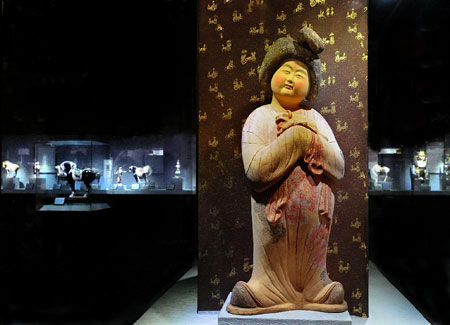
Photo taken on Dec. 18, 2011 shows a piece of classic-style Sancai porcelain work, which depicts a Tang-Dynasty servant maid, at a Sancai technique museum founded by local artist Gao Shuiwang in Mengjin County, Luoyang, central China’s Henan Province. Mr. Gao is a leading figure in the revival of Sancai, a Chinese porcelain characterized by a glaze with three intermingled colours. The producing technique of Sancai, which dates back to the Tang Dynasty (618-907 AD), was listed as one of China’s National Intangible Heritages in 2008. (Xinhua/Li An)

Photo taken on Dec. 18, 2011 shows a classic-style Sancai figure displayed at a Sancai technique museum founded by local artist Gao Shuiwang in Mengjin County, Luoyang, central China’s Henan Province. Mr. Gao is a leading figure in the revival of Sancai, a Chinese porcelain characterized by a glaze with three intermingled colours. The producing technique of Sancai, which dates back to the Tang Dynasty (618-907 AD), was listed as one of China’s National Intangible Heritages in 2008. (Xinhua/Li An)
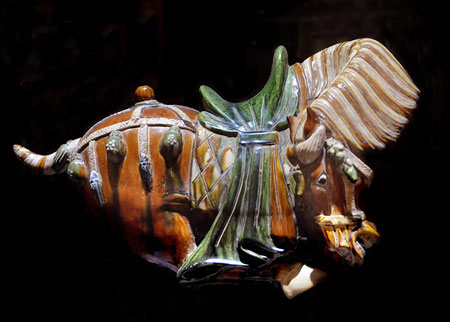
Photo taken on Dec. 18, 2011 shows a classic-style Sancai horse displayed at a Sancai technique museum founded by local artist Gao Shuiwang in Mengjin County, Luoyang, central China’s Henan Province. Mr. Gao is a leading figure in the revival of Sancai, a Chinese porcelain characterized by a glaze with three intermingled colours. The producing technique of Sancai, which dates back to the Tang Dynasty (618-907 AD), was listed as one of China’s National Intangible Heritages in 2008. (Xinhua/Li An)
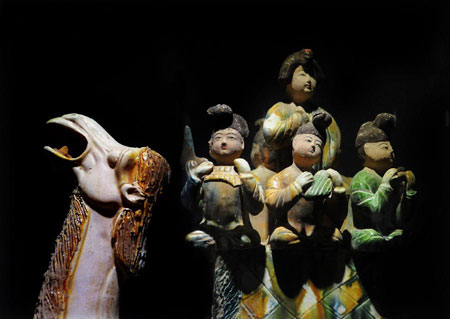
Photo taken on Dec. 18, 2011 shows a piece of classic-style Sancai porcelain work, which depicts Tang-dynasty musicians riding on a camel’s back, at a Sancai technique museum founded by local artist Gao Shuiwang in Mengjin County, Luoyang, central China’s Henan Province. Mr. Gao is a leading figure in the revival of Sancai, a Chinese porcelain characterized by a glaze with three intermingled colours. The producing technique of Sancai, which dates back to the Tang Dynasty (618-907 AD), was listed as one of China’s National Intangible Heritages in 2008. (Xinhua/Li An)
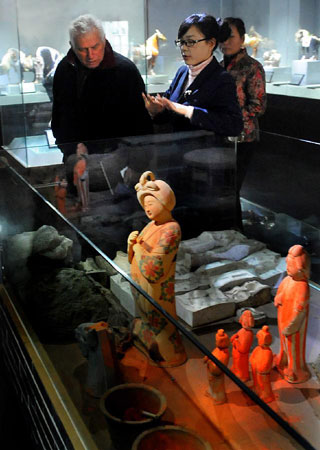
A foreign client learns about the production process of classic Sancai porcelain at a Sancai technique museum founded by local artist Gao Shuiwang in Mengjin County, Luoyang, central China’s Henan Province. Mr. Gao is a leading figure in the revival of Sancai, a Chinese porcelain characterized by a glaze with three intermingled colours. The producing technique of Sancai, which dates back to the Tang Dynasty (618-907 AD), was listed as one of China’s National Intangible Heritages in 2008. (Xinhua/Li An)
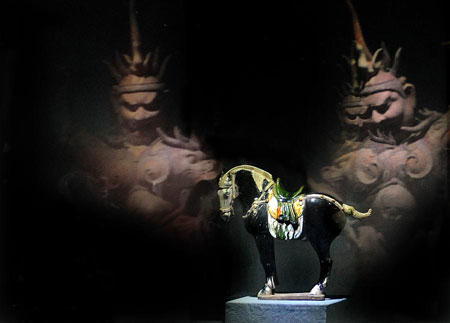
Photo taken on Dec. 18, 2011 shows a classic-style Sancai horse displayed at a Sancai technique museum founded by local artist Gao Shuiwang in Mengjin County, Luoyang, central China’s Henan Province. Mr. Gao is a leading figure in the revival of Sancai, a Chinese porcelain characterized by a glaze with three intermingled colours. The producing technique of Sancai, which dates back to the Tang Dynasty (618-907 AD), was listed as one of China’s National Intangible Heritages in 2008. (Xinhua/Li An)
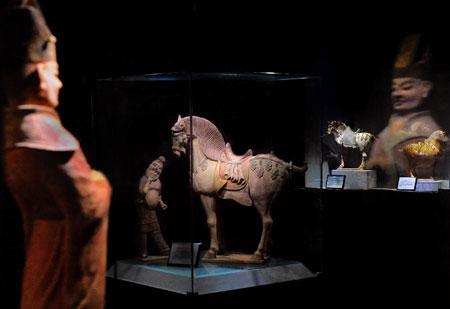
Photo taken on Dec. 18, 2011 shows a classic-style Sancai horse displayed at a Sancai technique museum founded by local artist Gao Shuiwang in Mengjin County, Luoyang, central China’s Henan Province. Mr. Gao is a leading figure in the revival of Sancai, a Chinese porcelain characterized by a glaze with three intermingled colours. The producing technique of Sancai, which dates back to the Tang Dynasty (618-907 AD), was listed as one of China’s National Intangible Heritages in 2008. (Xinhua/Li An)



